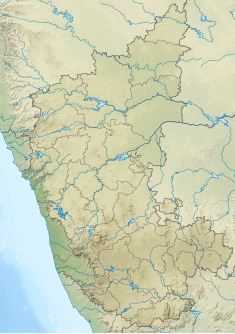
Back Aihole BAR ঐহোল Bengali/Bangla Aihole German Aĝole Esperanto Aihole Spanish ایهول Persian Aihole French ऐहोले Hindi Ajholé Hungarian Aihole Italian
| Group of monuments at Aihole | |
|---|---|
 Durga temple cluster at Aihole | |
| Location | Bagalkot, Karnataka, India |
| Nearest city | Hunagunda |
| Coordinates | 16°1′08″N 75°52′55″E / 16.01889°N 75.88194°E |
| Area | 5 square kilometres (1.9 sq mi) |
| Elevation | 810 m (2,657 ft) |
| Built | 4th–12th century CE |
| Architectural style(s) | Hindu, Jain, Buddhist temples and monasteries |
| Governing body | Gram panchayati Archaeological Survey of India |
Aihole (ಐಹೊಳೆ) (IPA: [eye-hoḷé][clarification needed]), also referred to as Aivalli, Ahivolal or Aryapura, is a historic site of ancient and medieval era Buddhist, Hindu and Jain monuments in Karnataka, India that dates from the sixth century through the twelfth century CE.[1][2][3] Most of the surviving monuments at the site date from the 7th to 10th centuries.[4] Located around an eponymous small village surrounded by farmlands and sandstone hills, Aihole is a major archaeological site, featuring over 120 stone and cave temples spread along the Malaprabha river valley, in Bagalakote district.[5]

Aihole is 35 kilometres (22 mi) from Badami and about 9.7 kilometres (6.0 mi) from Pattadakal, both of which are major centres of historically important Chalukya monuments. Aihole, along with nearby Badami (Vatapi), emerged by the 6th century as the cradle of experimentation with temple architecture, stone artwork, and construction techniques. This resulted in 16 types of free-standing temples and 4 types of rock-cut shrines.[6] The experimentation in architecture and arts that began in Aihole yielded the group of monuments at Pattadakal, a UNESCO World Heritage Site.[7][8]
Over 100 Aihole temples are Hindu, a few are Jain and one is Buddhist. These were built and coexisted in close proximity. The site is spread across about 5 square kilometres (1.9 sq mi).[9] The Hindu temples are dedicated to Shiva, Vishnu, Durga, Surya and other Hindu deities. The Jain Basadi temples are dedicated to Mahavira, Parshvanatha, Neminatha and other Jain Tirthankaras.[10] The Buddhist monument is a temple and small monastery. Both Hindu and Jain monuments include monasteries, as well as social utilities such as stepwell water tanks with artistic carvings near major temples.[8][11]
- ^ Himanshu Prabha Ray (2010). Archaeology and Text: The Temple in South Asia. Oxford University Press. pp. 17–18, 27. ISBN 978-0-19-806096-3.
- ^ Heather Elgood 2000, p. 151.
- ^ Jeffery D. Long (2011). Historical Dictionary of Hinduism. Scarecrow. p. 29. ISBN 978-0-8108-7960-7., Quote: "AIHOLE. Pronounced "Eye-ho-lé", village in northern Karnataka that, from the fourth to the sixth centuries CE, was a major city (...)"
- ^ Michell, George (1990), The Penguin Guide to the Monuments of India, Volume 1: Buddhist, Jain, Hindu, pp. 331–335, 1990, Penguin Books, ISBN 0140081445
- ^ Maurizio Forte; Stefano Campana; Claudia Liuzza (2010). Space, Time, Place: Third International Conference on Remote Sensing in Archaeology. Archaeopress. pp. 343–344. ISBN 978-1-4073-0659-9.
- ^ Centre, UNESCO World Heritage. "Evolution of Temple Architecture – Aihole-Badami- Pattadakal". UNESCO World Heritage Centre.
- ^ World Heritage Sites – Pattadakal – More Detail, Archaeological Survey of India, Government of India (2012)
- ^ a b Michell 2017, pp. 12–29, 78–86.
- ^ Maurizio Forte; Stefano Campana; Claudia Liuzza (2010). Space, Time, Place: Third International Conference on Remote Sensing in Archaeology. Archaeopress. pp. 343–344. ISBN 978-1-4073-0659-9.
- ^ Michell 2017, pp. 12–19.
- ^ Himanshu Prabha Ray (2010). Archaeology and Text: The Temple in South Asia. Oxford University Press. pp. 24–26. ISBN 978-0-19-806096-3.

